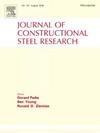在冻融循环条件下,通过挤出试验确定 SRC 的失效情况
IF 4
2区 工程技术
Q1 CONSTRUCTION & BUILDING TECHNOLOGY
引用次数: 0
摘要
本文通过冻融和推出试验,探讨了冻融循环、保护层厚度、预埋长度和体积环比对 SRC 接口粘结性能的影响。扫描电子显微镜的结果表明,暴露在冻融循环中的混凝土出现了明显的开裂,孔隙的数量和直径都有所增加。尽管混凝土外部受到了严重破坏,但界面的损坏程度要小得多。经过 200 次冻融循环后,试样的最大裂缝深度为 2.3 毫米,孔隙率为 35.1%。随着冻融循环的进行,试样在推出荷载作用下的破坏模式从劈裂过渡到界面剪切破坏。值得注意的是,端面的裂缝长度明显减少,大多数试样的侧面裂缝极少。此外,界面粘接应力随着循环次数的增加而逐渐减小。极限粘接应力比残余粘接应力下降得更快,在超过 100 次循环后,下降速度趋于稳定。保护层厚度、嵌入长度和体积环比的增加有效缓解了粘接应力的降低。其中,保护层的影响最大,其次是体积环比,而嵌入长度的影响最小。研究最后结合实验结果和理论分析,提出了冻融循环后粘结应力和滑移特征值的计算公式。本文章由计算机程序翻译,如有差异,请以英文原文为准。
Failure of the SRC under freeze- thaw cycles by the push-out tests
This paper explores the impact of freeze-thaw cycles, the thickness of the protective layer, embedment length, and volumetric hoop ratio on the bond performance at the SRC interface, assessed through freeze-thaw and push-out tests. Results from SEM indicated significant cracking in concrete exposed to freeze-thaw cycles, with an increase in both the number and diameter of pores. Despite significant damage to the concrete exterior, the interface exhibited considerably less deterioration. Following 200 freeze-thaw cycles, the specimens displayed a maximum crack depth of 2.3 mm and a porosity rate of 35.1 %. As the cycles progressed, the failure mode of specimens under push-out loading transitioned from splitting to interfacial shear failure. Notably, the length of cracks on the end surfaces was markedly reduced, and the majority of specimens exhibited minimal cracking on the side surfaces. Additionally, interfacial bond stress decreased progressively with the increasing number of cycles. The ultimate bond stress declined more rapidly than residual bond stress, with the rate of decrease stabilizing after surpassing 100 cycles. Enhancements in protective layer thickness, embedment length, and volumetric hoop ratio effectively mitigated the reductions in bond stress. Among these, the protective layer had the most significant impact, followed by the volumetric hoop ratio, while embedment length had the least influence. The study concludes with proposed formulas for calculating bond stress and slip eigenvalues after freeze-thaw cycles, integrating experimental results and theoretical analysis.
求助全文
通过发布文献求助,成功后即可免费获取论文全文。
去求助
来源期刊

Journal of Constructional Steel Research
工程技术-工程:土木
CiteScore
7.90
自引率
19.50%
发文量
550
审稿时长
46 days
期刊介绍:
The Journal of Constructional Steel Research provides an international forum for the presentation and discussion of the latest developments in structural steel research and their applications. It is aimed not only at researchers but also at those likely to be most affected by research results, i.e. designers and fabricators. Original papers of a high standard dealing with all aspects of steel research including theoretical and experimental research on elements, assemblages, connection and material properties are considered for publication.
 求助内容:
求助内容: 应助结果提醒方式:
应助结果提醒方式:


